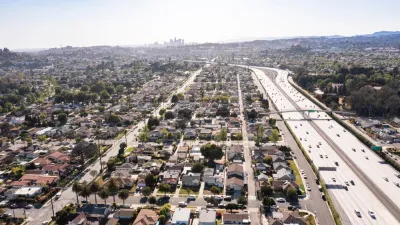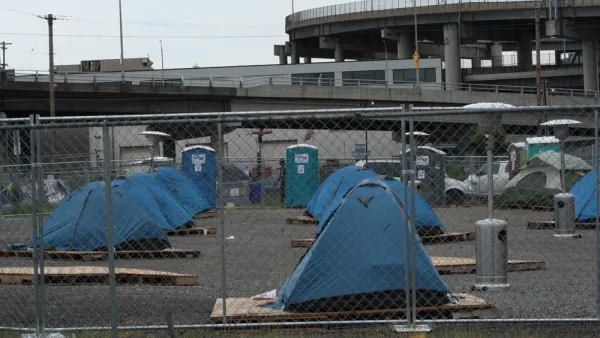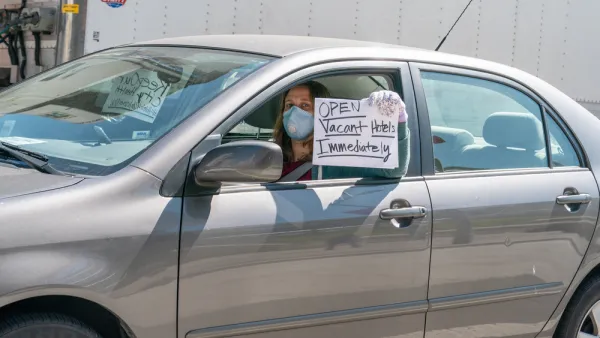Los Angeles is the nation's capital of both crowding and sprawl. A feature published by the Los Angeles Times provides the history of how the metropolis achieved this contradiction.

Whether it's fair nor not, Los Angeles is a symbol of the unfettered expansion of sprawl in the United States. So that should mean backyards and large, spacious homes for everyone, right?
Look beneath the surface, however, and the reality of the Los Angeles region is revealed as an overcrowded housing market—multiple families and households shoehorning into a housing supply not built to handle the demand of the nation's most populous county.
A feature article by Brittny Mejia, Liam Dillon, and Gabrielle Lamar Lemee, and Sandy Kambhampati for the Los Angeles Times looks past the symbolic region to reveal the consequences of the reality of Los Angeles, focusing on the consequences of overcrowded housing during the pandemic.
"At the heart of the storied metropolis of single-family-home sprawl, L.A. leaders created a cruel paradox: It is also the country’s most crowded place to live," According to the analysis reported here by the Los Angeles Times, Los Angeles County has more overcrowded housing than any other large county in the United States—a fact that has remained true for three decades.
During the pandemic, the region's hidden overcrowding in single-family homes had tragic consequences. The article places the blame for high covid death rates in low-income communities on the historic decisions made by planners and politicians: "This public health disaster was the inevitable consequence of more than a century of decisions that resulted in L.A. growing more like an endless suburb than a towering city."
- Related from Planetizen: Overcrowded Housing Connected to Coronavirus Infection (June 2020)
- Related from Planetizen: Los Angeles Mayor Blames COVID Outbreak on Density (January 2021)
- Related from Planetizen: The Link Between COVID-19 Deaths and Overcrowded Housing (July 2021)
To explain how Los Angeles achieved its paradox, the team of journalists "reviewed historical archives, oral histories and newspaper accounts, analyzed decades of U.S. census data and conducted dozens of interviews with academic experts, public officials, residents of cramped apartments and people whose family legacies in the region date back more than a century." They found a singular thread:
L.A.’s leaders could have addressed deplorable living conditions for the region’s poorest residents with more apartments, taller buildings and public housing. But they saw those ideas as anathema to the Southern California lifestyle they were creating. So in working-class neighborhoods, more and more people crammed into the existing housing stock, particularly as new streams of immigrants came from Mexico and Central America.
The entire history, along with damning judgments for 20th century planning and a warning for 21st century planning, can be read in the source article.
FULL STORY: L.A.’s love of sprawl made it America’s most overcrowded place. Poor people pay a deadly price

National Parks Layoffs Will Cause Communities to Lose Billions
Thousands of essential park workers were laid off this week, just before the busy spring break season.

Retro-silient?: America’s First “Eco-burb,” The Woodlands Turns 50
A master-planned community north of Houston offers lessons on green infrastructure and resilient design, but falls short of its founder’s lofty affordability and walkability goals.

Delivering for America Plan Will Downgrade Mail Service in at Least 49.5 Percent of Zip Codes
Republican and Democrat lawmakers criticize the plan for its disproportionate negative impact on rural communities.

Test News Post 1
This is a summary

Test News Headline 46
Test for the image on the front page.

Balancing Bombs and Butterflies: How the National Guard Protects a Rare Species
The National Guard at Fort Indiantown Gap uses GIS technology and land management strategies to balance military training with conservation efforts, ensuring the survival of the rare eastern regal fritillary butterfly.
Urban Design for Planners 1: Software Tools
This six-course series explores essential urban design concepts using open source software and equips planners with the tools they need to participate fully in the urban design process.
Planning for Universal Design
Learn the tools for implementing Universal Design in planning regulations.
EMC Planning Group, Inc.
Planetizen
Planetizen
Mpact (formerly Rail~Volution)
Great Falls Development Authority, Inc.
HUDs Office of Policy Development and Research
NYU Wagner Graduate School of Public Service





























